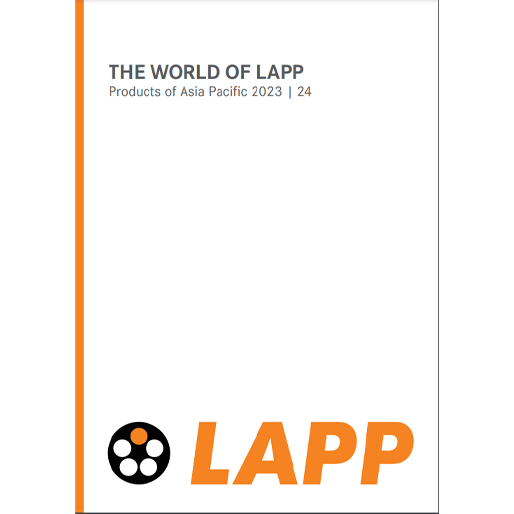Ethernet Protocol Standards


PROFINET®
PROFINET® is the leading open industrial Ethernet standard in Europe for all areas of industrial automation technology. This type of communication system enables data to be exchanged in real time between controller devices and field devices using industrial Ethernet. PROFINET® is the successor to PROFIBUS®, a fieldbus protocol standard which is standardised by the PROFIBUS & PROFINET International (PI) user organisation. LAPP is playing an active role in further developing PROFINET®.
The RT (Real Time) variant of PROFINET® enables controller devices and field devices to communicate in real time. No additional requirements need to be placed on the network components to do so. The cycle times for exchanging data without any clock synchronisation are approx. 10 milliseconds. The RT variant is used in remote I/O systems, for example.
When it comes to special applications that require clock synchronisation, e.g. synchronisation of servo drives, it is essential to use isochronous communication between the controller device and field device, as provided by the IRT (Isochronous Real Time) variant of PROFINET®. IRT networks place additional requirements on the hardware, and standard Ethernet switches are no longer permitted. The cycle times for exchanging data are less than 1 millisecond.
Copper cables and components in accordance with the PROFINET® standard
Copper cables
The PROFINET®-compliant copper cables from LAPP’s ETHERLINE® range have the inscription “PN” or “PNA”, “PNB” or “PNC”, which indicates at a glance that they are suitable for PROFINET® applications and shows their type specification (A = fixed installation, B = flexible installation or C = continuous flexing installations, installation involving torsion, or other). Depending on the type of application concerned, different types of cables are used for PROFINET® cabling: either cables with 4 cores enabling 100 Mbit/s, or cables with 8 cores enabling Gigabit-level performance.
- Cables from cat. 5
- Cables from cat. 6A
- Cables from cat. 7
Connectors
You can find matching PROFINET® connectors for connecting your field devices (RJ45 and M12 connectors, D or X coding) in the EPIC® DATA range.
- RJ45 field-configurable
- RJ45 top-hat rail adapter
- RJ45 coupling
- M12D
- M12X
Patch cables
These pre-assembled data cables including connectors round off LAPP’s portfolio and are directly available as a complete solution for use in PROFINET® applications. This helps you avoid spending time on assembly and prevents differences in connection quality, and even enables you to attain a higher protection class than can be achieved using freely-configurable connectors.
- Patch cables from cat. 5
Switches
When it comes to connecting your cables, the ETHERLINE® ACCESS series can offer various compact standard Ethernet switches for PROFINET® (conformity class CC-B).
- Managed switches for PROFINET® systems
Fibre optic cables and components in accordance with the PROFINET® standard
Fibre optic cables
Instead of copper cables, PROFINET® systems often also use fibre optic cables as they are resistant to electromagnetic interference and enable data to be transferred over longer distances. PROFINET®-compliant fibre optic cables are available in the HITRONIC® range as the POF or PCF version. You can choose from two different sheath designs to suit the industrial environment and cable stresses concerned.
- Fibre optic cables made from polymer optical fibre (POF) for type B or C applications, duplex fibre cable version
- Fibre optic cables with plastic cladded glass fibre (PCF) for type B or C applications, duplex fibre cable version
Connectors
The HITRONIC® range includes matching connectors for your duplex cable, which enables the use of fibre optic cables for PROFINET® data cabling.
- Connectors for POF fibres
- Connectors for PCF fibres
Other common industrial Ethernet protocol standards
LAPP combines the following industrial Ethernet protocol standards (described below) in categories for copper cables, fibre optic cables and components: Modbus TCP, EtherNET/IP, CC-Link IE and POWERLINK. They can be found at the end of the following industrial Ethernet protocol standards.
Modbus TCP
Modbus TCP is the Ethernet counterpart to the Modbus fieldbus system, which was developed to enable serial communication between devices and is independent of the physical layer. To facilitate Ethernet communication in automation applications, the transport protocol TCP/IP, the transfer medium Ethernet (with its higher transfer rates) and the actual Modbus application protocol were combined to create a very open system that has now become one of the standards for process automation.
As such, the Modbus TCP technology can be considered to be a fieldbus-on-Ethernet solution, which enables messages to be exchanged between one or more clients and one or more servers with different bus and network topologies. As part of this, the equipment can take on both roles simultaneously, communicate in parallel and send numerous queries/responses. Modbus TCP is maintained by the Modbus Organization.
Please note that Modbus TCP requires copper cables with at least 8 cores (cat. 6 or higher).
EtherNET/IP
EtherNET/IP is an industrial bus system for use in control and automation systems, and is increasingly being used in the American region.
EtherNET/IP operates using standard Ethernet hardware and uses the transport protocols TCP/IP and UDP. It also uses the application protocol CIP (Common Industrial Protocol), which constitutes the application layer in the network. One key advantage offered by this open industrial standard is that it is easy to integrate existing field devices with a serial RS interface. The communication services supply the automation application with cyclic and time-critical data from the field level.
However, since such networks are able to achieve cycle times of “only” around 10 ms, the communication standard is not, by itself, suitable for handling the demanding real-time requirements of isochronous servo operation (< 1 ms). For applications requiring clock synchronisation, the protocol was therefore expanded to include MotionSync and CIPSync.
EtherNET/IP is maintained and further developed by the Open DeviceNet Vendor Association (ODVA).
LAPP is a member of the ODVA and plays an active role in further developing the EtherNET/IP system.
CC-Link IE
In Asia, CC-Link IE is the leading Ethernet-based successor standard to the CC-Link fieldbus system. In industrial applications where CC-Link reaches its limits as a fieldbus system, the more powerful CC-Link Industrial Ethernet variant is used to manage considerably larger volumes of data. This standard for high-speed data transfer offering Gbit-level performance supplies real-time protocols and can currently connect up to 120 devices within a network. CC-Link IE is available in versions including CC-Link IE Field (for exchanging data at field level), CC-Link IE Control (for exchanging data at controller level), CC-Link IE Safety (for linking safety controllers for secure communication) and CC-Link IE Field Motion (for synchronising servo drives).
LAPP is a member of the CLPA (CC-Link Partner Association) user organisation and plays an active role in further developing the standard. Many of the components offered below have been certified in accordance with CLPA specifications.
POWERLINK
POWERLINK is an open, real-time-capable protocol enhancement of the basic Ethernet technology. It is currently the leading real-time Ethernet system used in automation technology. Within this network, isochronous cycles with a cycle time of < 200 µs and timing precision of < 1 µs are achieved for deterministic data exchange, up to 240 nodes are precisely synchronised with one another, different network types are integrated, and the topology can be freely selected. A time window was also established for non-time-critical data relating to the device configuration or diagnostics. POWERLINK takes advantage of IP-based protocols such as UDP and TCP, as well as CANopen profiles. This, of course, also ensures IT interoperability. No special hardware is required for the master and slave nodes (managing nodes and controlled nodes).
POWERLINK is being further developed by the EPSG (Ethernet POWERLINK Standardization Group).
Copper cables and components for the IE protocols
Copper cables, connectors and patch cables
When selecting your components, please note that a connector will restrict a cable’s transfer properties if the connector is from a lower category.
- Cables and connectors from cat. 5 / 5e
- Cables from cat. 6
- Cables from cat. 6A
- Cables from cat. 7
Switches
- Managed and unmanaged switches
Fibre optic cables and components for the IE protocols
Fibre optic cables
Instead of copper cables, industrial communication systems often also use fibre optic cables as they are resistant to electromagnetic interference and, therefore, allow for an improved data transfer over longer distances. The HITRONIC® range includes matching fibre optic cables for the protocol standards Modbus TCP, EtherNET/IP, CC-Link IE and POWERLINK in the GOF version. You can choose between single-mode (SM) or multi-mode (MM) fibre cables depending on the industrial environment, wavelength and transmission path concerned.
- Fibre optic cables made from glass optical fibre (GOF), single-mode or multi-mode
Connectors
If you are an experienced cable assembler who is familiar with the bonding and polishing process, LAPP can provide suitable GOF type LC, SC, ST and FC connectors in different classes.
- Connectors
Pigtails, patch cords and trunks
To ensure you obtain the ideal pre-assembled glass fibre cable offering optimum fibre quality, you can choose from an extensive range of accessories. This could be pigtails equipped with connectors on one side for connecting to an existing installation cable by means of splicing, or patch cables equipped with connectors on both sides for directly connecting two active optical components.
Alternatively, you can also contact us to obtain a tailor-made fibre optic cable assembly (trunk system). You will then benefit from a ready-to-connect cabling system which will significantly reduce the work required on site.
- SIMPLEX pigtails in set of 12, standard length of 2 m
- DUPLEX individual patch cables, standard length of 2 m
- Trunk systems, available on request
Switches
In order to securely and reliably interconnect the various participants in an industrial Ethernet system, active network components are required in glass fibre networks as well. The two managed LAPP switches with SFP ports for connecting fibre optic cables are available in a 100 Mbit/s or 1 Gbit/s version, for single-mode or multi-mode data transfer.
- Switches with fibre optic cable port for glass fibre cables (coming soon)




